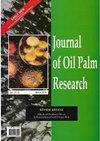油棕成熟林荫下豚草和杂交种的营养筛选及产草量
IF 1.3
4区 农林科学
Q2 Agricultural and Biological Sciences
引用次数: 0
摘要
本文章由计算机程序翻译,如有差异,请以英文原文为准。
NUTRITIVE SCREENING AND FORAGE YIELD OF GUINEA AND HYBRID NAPIER GRASS VARIETIES UNDER DENSE SHADE OF MATURE OIL PALM PLANTATION
Cattle grazing and sparse weed flora due to poor light infiltration in mature oil palm plantations have created a need for the identification of shade tolerant fodder grass varieties. A total of 14 varieties of Guinea grass and four varieties of hybrid Napier were screened for 4 years under dense shade of mature oil palm plantation. Significant differences were observed among the fodder grass varieties evaluated for fodder yield and nutritive quality attributes. Of all the varieties, Sampoorna (24.55 t/ha), CO-4 (22.52 t/ha) and KKM-1 (22.34 t/ha) among hybrid Napier grass and BG-1 (23.12 t/ha), DGG-1 (22.00 t/ha), CO-3 (21.38 t/ha) and Grazing Guinea-1 (20.28 t/ha) among Guinea grass have been identified as promising fodder yielders. Overall, better nutritive levels in fodder quality attributes like crude protein (11.88%), crude fat (2.15%), neutral detergent fibre (66.75%), acid detergent fibre (44.37%), lignin (8.91%) and acid insoluble ash (6.00%) were observed in Sampoorna. Because of unique/sturdy growth habit, better adaptation and optimum fodder yield, Sampoorna along with Grazing Guinea-1 can be the most suitable option for a sustainable oil palm-based farming system.
求助全文
通过发布文献求助,成功后即可免费获取论文全文。
去求助
来源期刊

Journal of Oil Palm Research
农林科学-食品科技
CiteScore
2.60
自引率
30.80%
发文量
69
审稿时长
>12 weeks
期刊介绍:
JOURNAL OF OIL PALM RESEARCH, an international refereed journal, carries full-length original research papers and scientific review papers on various aspects of oil palm and palm oil and other palms. It also publishes short communications, letters to editor and reviews of relevant books. JOURNAL OF OIL PALM RESEARCH is published four times per year, i.e. March, June, September and December.
 求助内容:
求助内容: 应助结果提醒方式:
应助结果提醒方式:


